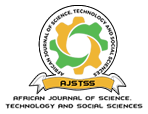Distribution and genetic diversity of cystic echinococcosis in a non-endemic region: a one health approach
DOI:
https://doi.org/10.58506/ajstss.v1i1.76Keywords:
Cystic echinococcosis, zoonotic diseases, Echinococcus granulosusAbstract
Background: Cystic echinococcosis (CE), caused by Echinococcus granulosus sensu lato (s. l.) is an endemic zoonosis in pastoral communities in Kenya. However, the spread of CE to non-endemic areas is possible due to livestock trade, dogs’ roaming behaviour and limited knowledge on CE transmission. This study determined the presence of CE in humans, the genetic variability of the parasite in livestock and the role of dogs in the establishment of lifecycle in a non-endemic region.
Methodology: Screening of human CE in Bungoma County was performed using a portable ultrasound scanner, while livestock cysts were collected during meat inspection in Busia and Bungoma slaughterhouses. Around each slaughterhouse, ten dog-keeping homesteads were selected and from each homestead a dog faecal sample was collected for microscopic examination of taeniid eggs and other helminths. Copro-ELISA was performed on the dog faecal samples for detection of E. granulosus s. l. Polymerase chain reaction-restriction fragment length polymorphism and sequencing were performed to genotype taeniid eggs, characterize CE livestock cysts and determine the genetic diversity of E. granulosus sensu stricto (s. s.). Results: Out of 1002 people screened for CE; 67 (6.7%) participants had abnormal findings and, of these, 7 (1.1%) had simple liver cysts classified as CL by WHO. In livestock, E. granulosus s. s. was identified in 135/153 cysts. Eleven haplotypes for Nad1 and 19 for Cox1 gene were identified in E. granulosus s. s. Helminths detected in dogs included hookworms (n=92; 59.4%), ascarids (n=15; 9.7%), and taeniid (n=1; 0.6%). The sequences of nine (9) taeniid eggs recovered from the single taeniid positive sample identified as E. canadensis (1), T. multiceps (1) and T. serialis (6). Copro-ELISA was positive in 12/77 (15.6%) faecal samples. Conclusion: This study report for the first time E. granulosus s. s. haplotypes in livestock in East Africa and the establishment of E. granulosus s. l. and taeniids life cycle in a non-endemic region.


